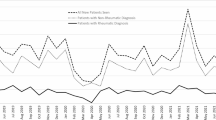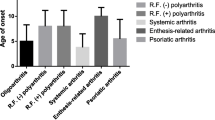Abstract
Pediatric rheumatology is a well-established subspecialty in just 4 of 11 Southeast Asia countries. With the development of a dedicated pediatric rheumatology clinical program in Singapore and the establishment of an Internet-based registry, insights into local disease descriptions and epidemiology are possible. Concurring with reports from other parts of Asia and the West, a comparable proportion of referrals were for nonrheumatic conditions, although specific disease distributions were different. Juvenile idiopathic arthritis (JIA), vasculitides, and systemic lupus erythematosus are among the common rheumatic diseases seen in Singapore. Other than Henoch-Schönlein purpura and Kawasaki disease, other forms of systemic vasculitides are rare. JIA subtype distribution was unique, with enthesitis-related JIA showing predominance. Epidemiologic data are limited. Singapore has less of a biologic accessibility issue than other countries in Southeast Asia due to a stronger economy and strong financial support from foundations/organizations. As a multicultural Asian society, Singapore has traditional/alternative medicine practice as part of its health care system. Raising pediatric rheumatic disease awareness in the medical community and among the public is crucial to improving referral behavior and avoiding diagnosis delay and improper management. An urgent need exists for pediatric rheumatologists in Southeast Asia. With many differences between the East and West, establishment of a local, comprehensive, hands-on pediatric rheumatology fellowship training program may be a better strategy to decrease the patient-to-doctor ratio, eventually leading to an improvement in overall childhood-onset rheumatic disease outcomes.

Similar content being viewed by others
References
Arkachaisri T: Pediatric Rheumatology in Asia: The Thai Experience. Pediatric Rheumatology Online Journal 2004, 2(3):286-294.
List of countries by population: http://en.wikipedia.org/wiki/List_of_countries_by_population 2010
Spencer CH: Why should pediatric rheumatology be recognized as a separate subspecialty: an open letter to medical councils and government agencies. Pediatric Rheumatology 2007, 5(21):1-3.
Singapore Department of Statistics: Census of Population 2010. Advance Census Release. Available at http://wwwsingstatgovsg/pubn/popn/c2010acrpdf. 2010.
WHO: The Burden of Musculoskeletal Conditions at the Start of the New Millennium: report of a WHO scientific group. Geneva, Switzerland; 2003.
Bowyer S, Roettcher P: Pediatric rheumatology clinic populations in the United States: results of a 3 year survey. Pediatric Rheumatology Database Research Group J Rheumatol 1996, 23:1968-1974.
Hashkes PJ, Uziel Y, Rubenstein M, Navon P, Padeh S, Mukamel M, Brik B, Press J, Tauber T, Harel L et al: The Israeli internet-based registry: Novel concept of multicenter data collection in pediatric rheumatology. Pediatric Rheumatology Online Journal 2004, 2(1):37-50.
Malleson PN, Fung MY, Rosenberg AM: The incidence of pediatric rheumatic diseases: results from the Canadian Pediatric Rheumatology Association Disease Registry. J Rheumatol 1996, 23:1981-1987.
Pelkonen PM, Jalanko HJ, Lantto RK, Maleka AL, Pietikainen MA, Savolainen HA, Verronen PM: Incidence of systemic connective tissue diseases in children: a nationwide prospective study in Finland. . J Rheumatol 1994, 21:2143-2146.
Rosenberg AM: Longitudinal analysis of a Pediatric Rheumatology Clinic population. J Rheumatol 2005, 32(10):1992-2001.
Sawhney S, Magalhaes CS: Paediatric rheumatology--a global perspective. Best Pract Res Clin Rheumatol 2006, 20(2):201-221.
Fujikawa S, Okuni M: A nationwide surveillance study of rheumatic diseases among Japanese children. . Acta Paediatr Jpn 1997, 39:242-244.
Huang JL, Yao TC, See LC: Prevalence of pediatric systemic lupus erythematosus and juvenile chronic arthritis in a Chinese population: a nation-wide prospective population-based study in Taiwan. Clin Exp Rheumatol 2004, 22(6):776-780.
Cassidy JT: Introduction to the Study of Pediatric Rheumatic Diseases, edn 5. Philadelphia: Elsevier Saunders; 2005.
Chandrasekaran AN, Rajendran C, Madhavan R: Juvenile rheumatoid arthritis--Madras experience. Indian J Pediatr 1996, 63:501-510.
Fujikawa S, Okuni M: Clinical analysis of 570 cases with juvenile rheumatoid arthritis: results of a nationwide retrospective survey in Japan Acta Paediatr Jpn 1997, 39:245-249.
Khuffash FA, Majeed HA, Lubani MM, Najdi KN, Gunawardana SS, Bushnaq R: Epidemiology of juvenile chronic arthritis and other connective tissue diseases among children in Kuwait. . Ann Trop Paediatr 1990, 10(255-259).
Seth V, Kabra SK, Semwal OP, Jain Y: Clinico-immunological profile in juvenile rheumatoid arthritis--an Indian experience. Indian J Pediatr 1996, 63(293-300).
Wu CJ, Huang JL, Yang MH, Yan DC, Ou LS, Ho HH: Clinical characteristics of juvenile rheumatoid arthritis in Taiwan. J Microbiol Immunol Infect 2001, 34(3):211-214.
Acknowledgment
The author wishes to thank Ms. Hoh Sook Fun, rheumatology resource nurse, for the RECORD data maintenance; Dr. Tan Teng Hong, cardiology service, and Dr. Liew Woei Kang, rheumatology and immunology service at KKH, for the 10-year KKH KD registry data; and Dr. Elizabeth Ang and Dr. Lynette Shek for the NUH data. The author also wishes to thank the NAF for its support of RECORD development.
Disclosure
No potential conflict of interest relevant to this article was reported.
Author information
Authors and Affiliations
Corresponding author
Rights and permissions
About this article
Cite this article
Arkachaisri, T. Pediatric Rheumatology in Southeast Asia: Insights from the Singapore Experience. Curr Rheumatol Rep 13, 117–122 (2011). https://doi.org/10.1007/s11926-010-0159-1
Published:
Issue Date:
DOI: https://doi.org/10.1007/s11926-010-0159-1




